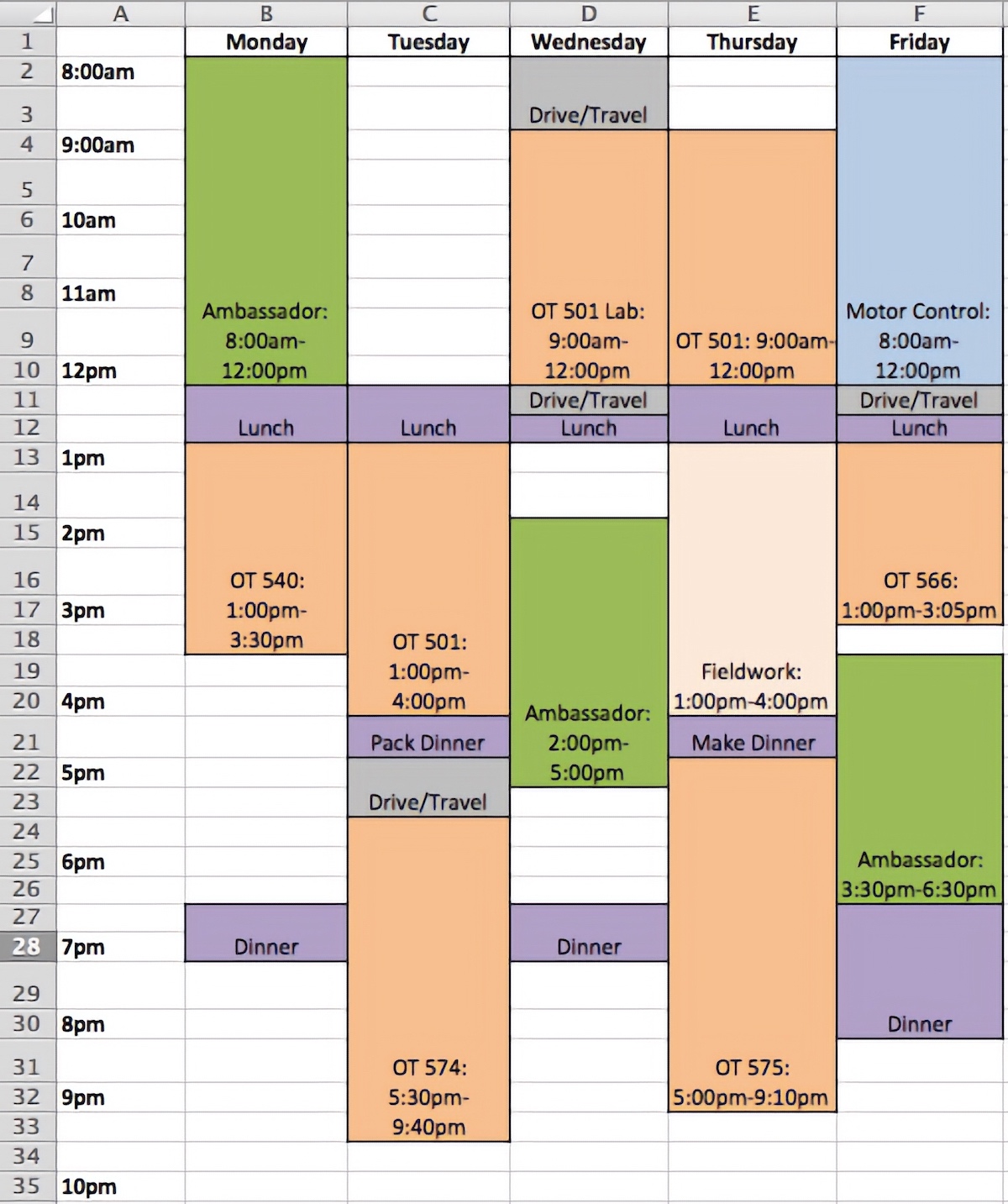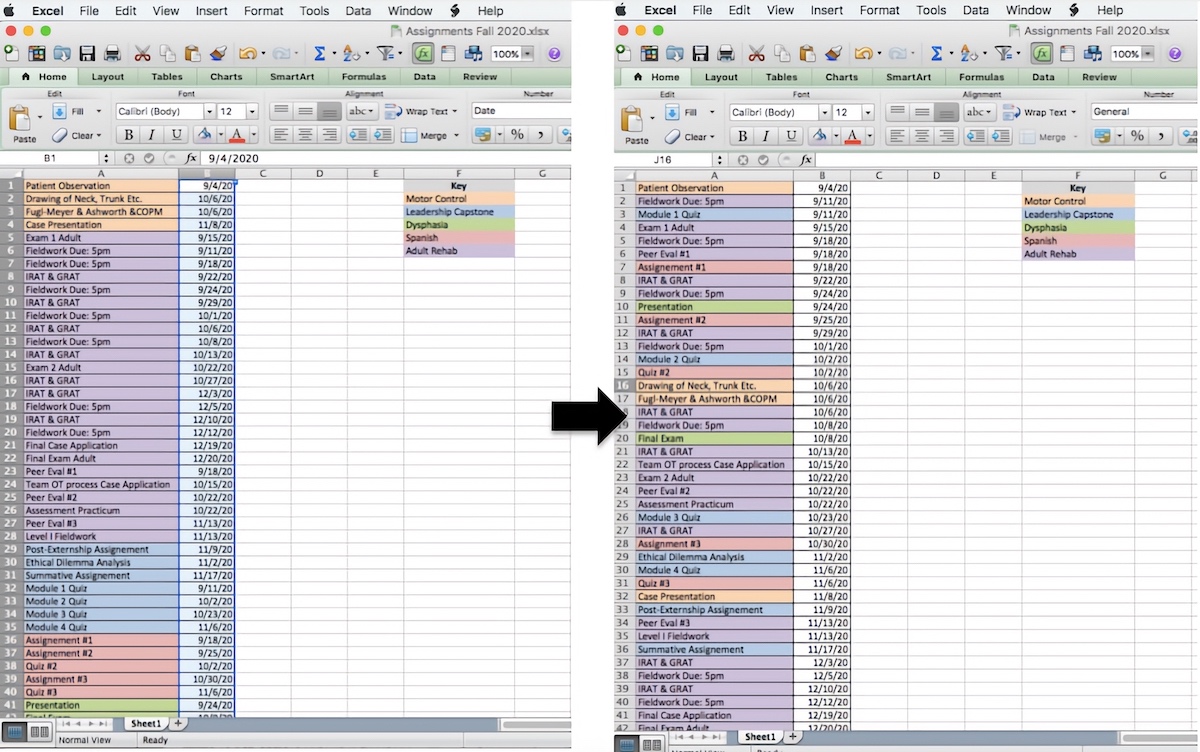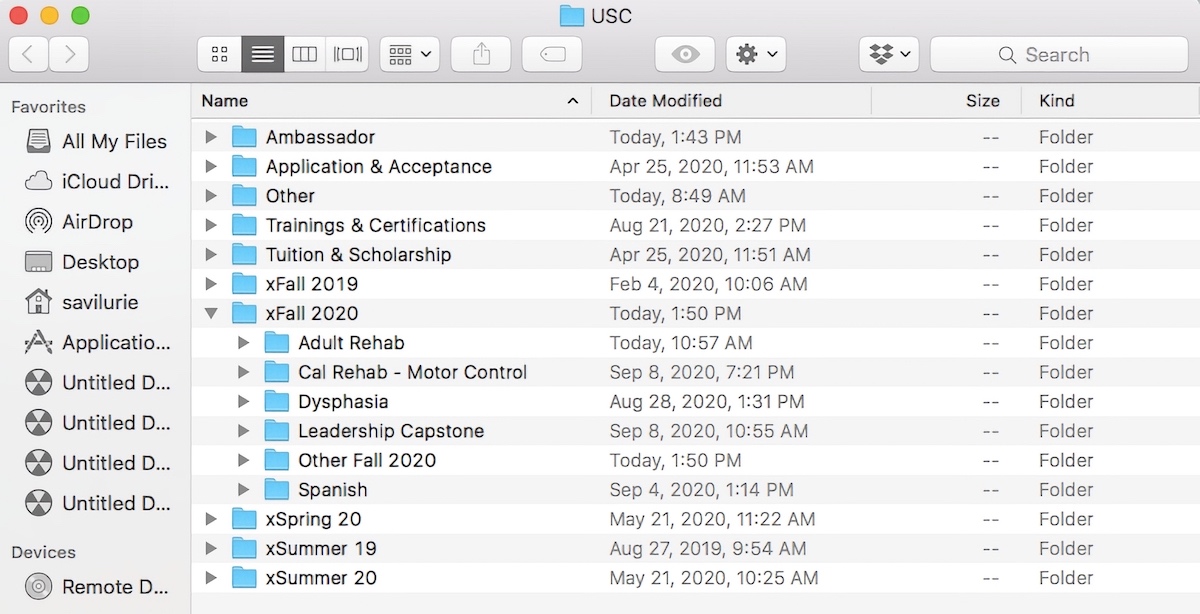Student Blog
Savi
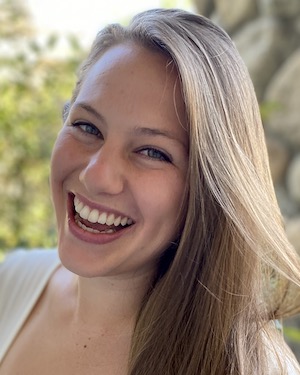
Savi’s Electives Experiences ⟩
October 7, 2020, by Savi
Over the past two semesters, I have had the opportunity to choose between a variety of elective courses to take in order to dive deeper into the subject matter I am interested in and begin my journey from an OT generalist to specialist. As a second year in the Master’s program, students are given the chance to take 12-14 units of elective coursework so that they can begin to focus in an area of interest.
When I began this Master’s program I was extremely interested in taking the OT 561: Occupational Therapy in Acute Care elective, as I have always been interested in pursuing a career in acute care. Unfortunately, this elective was no longer offered this semester as they wanted to keep all students, faculty, and patients healthy and at a safe distance. Although this was sad news for me, this decision also allowed me to explore electives I wouldn’t have otherwise! Now looking back on my decisions and experiences I could not have imagined it any other way! I love all of my electives and have learned such valuable information that will help guide me in whatever practice setting I choose in the future. Here is a glimpse into my electives and why I chose them!
OT 574: Enhancing Motor Control for Occupation
This semester I was fortunate enough to have been randomly selected to take the Motor Control elective at the California Rehabilitation Institute. This course has opened my eyes to so many unique and fun things OTs can do in an inpatient rehabilitation setting. Before beginning this course I knew that I wanted to hopefully work as an OT in an inpatient rehabilitation or acute setting after graduation, but was worried I wouldn’t have experience working with patients in either of these settings. This course provided me with four hours of weekly clinical experience with patients guided by an assigned clinical instructor, as well as lecture material focused on providing tangible methods for remediation of motor control problems following upper motor neuron lesions. In lectures, we spent half the time learning the theories and concepts of motor control and motor learning, and then the other half applying our knowledge and skills in practice. Through this class, I learned how to complete scapular and trunk assessment, facilitation, and mobilization, shoulder subluxation positioning and taping, inhibitory casting, neuromuscular electrical stimulation, edema management, and much more! Check out the pictures at the bottom to see what these look like. I had a lot of fun working with patients and applying my knowledge in real-time with the assistance of experienced OTs.
OT 575: Dysphasia Across the Lifespan
As a food lover myself, I have always listed eating as my #1 favorite occupation. After working in a few pediatric settings and seeing how impactful OTs can be in the feeding process, I wanted to learn more about our impact across the lifespan. This course has provided me with an immense amount of knowledge regarding the various assessment and treatment strategies used for patients and caregivers. I have also gained a greater understanding of the oral, pharyngeal, and esophageal anatomical structures involved in swallowing and how they relate to normal and abnormal swallowing. On the last day of class we all received a large box of delicious snacks to eat and test out. This helped us gauge the sensory qualities, understand the effects chewing has on consistency and texture, and brainstorm fun activities with each snack option to engage our future clients.
OT 566: Healthcare Communication with Spanish-Speaking Clients
¡Hola! Mi nombre es Savi y yo soy su terapeuta ocupacional. I am extremely passionate about developing a comfortable and safe environment for all my clients. During my time completing observation hours in San Diego and fieldwork in Los Angeles, I have noticed that a large quantity of the patients and clients I have worked with are primarily Spanish speaking. Because of the language barrier, I felt as though I am not able to make them feel as comfortable as I could. I, therefore, wanted to take advantage of this opportunity to learn how to communicate in Spanish at an elementary level in a therapeutic context. By doing so I have learned how to say common OT phrases and terms in Spanish, to facilitate better connections and relationships with my future clients. Dr. Delgado has brought in OTs from a variety of settings to help us learn context-specific and cultural terms and phrases. Gracias, Profesor Delgado!
OT 564 Sensory Integration Theory
I decided to take sensory integration (SI) theory because I wanted to get a better understanding of the neuroscience backing and foundation for sensory integration. After completing the pediatrics immersion, I didn’t feel confident about the level of understanding I had regarding SI in comparison to other students I had spoken to in my cohort. This made me extremely nervous since SI is so important and prevalent in OT practice across all settings. I, therefore, wanted to get a better grasp on the neurobehavioral principles of Sensory Integration Theory before entering into my Level II fieldwork and eventually sitting for the NBCOT exam. This class did just that!
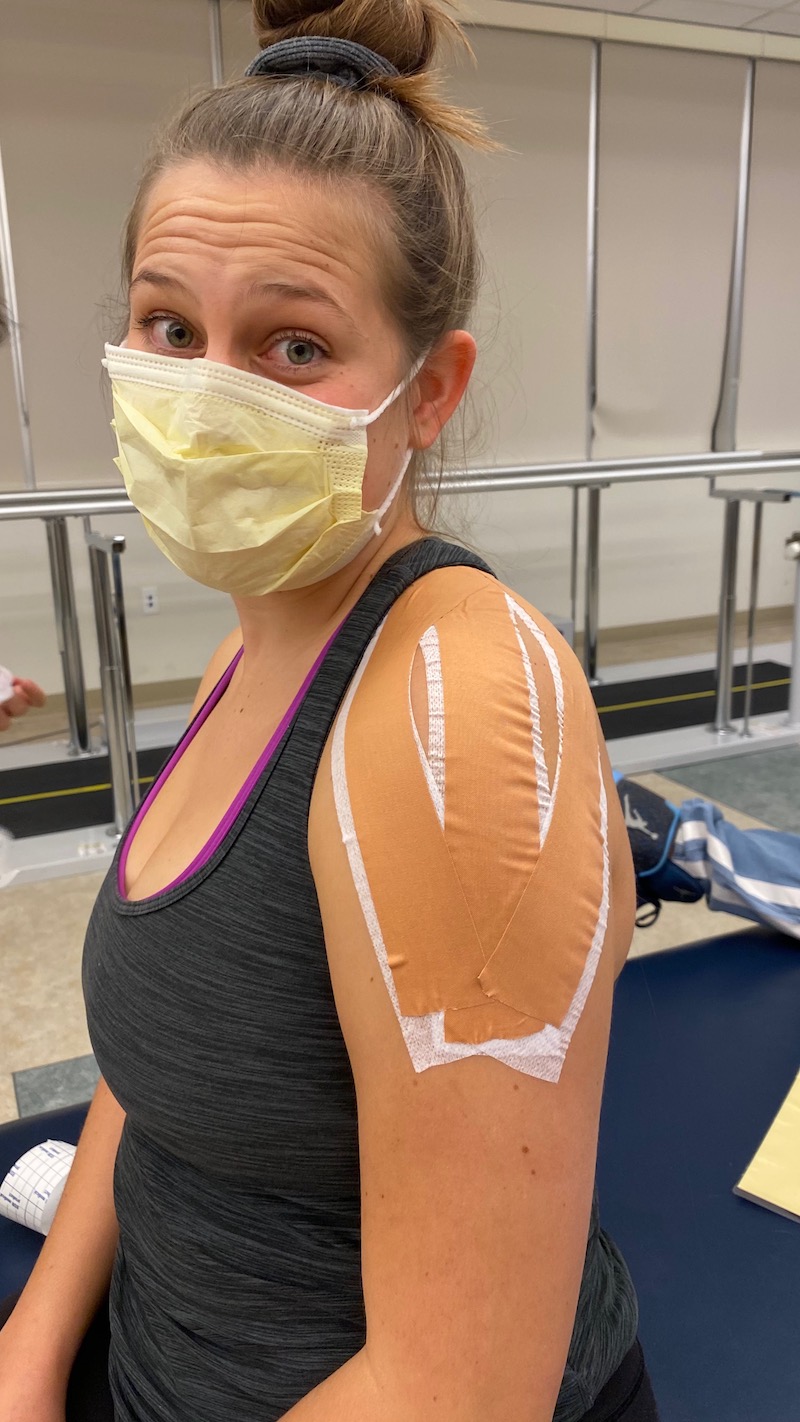
Showing off my shoulder taping, which is used to assist with realigning and supporting a shoulder joint with subluxation.
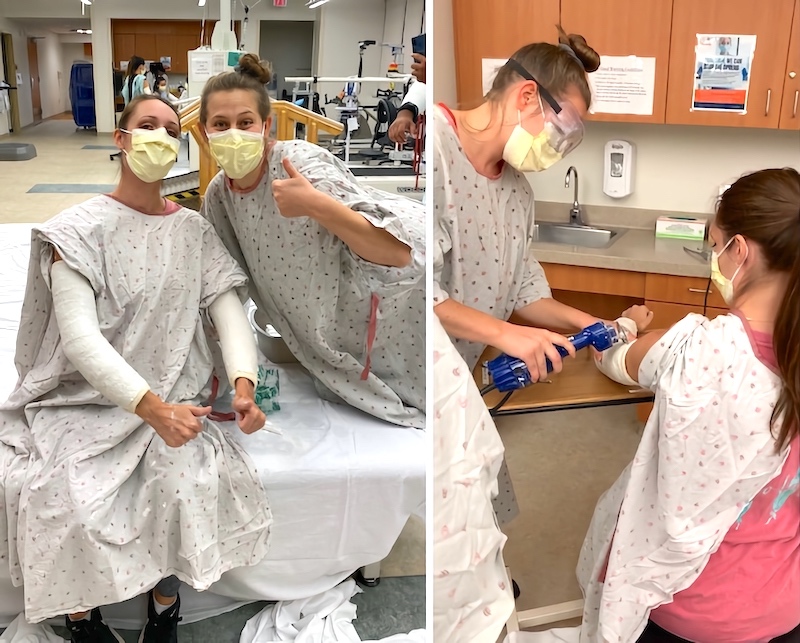
Practicing serial casting on classmate Alana Schoenhals to manage tone. We even got to saw off the cast we made!
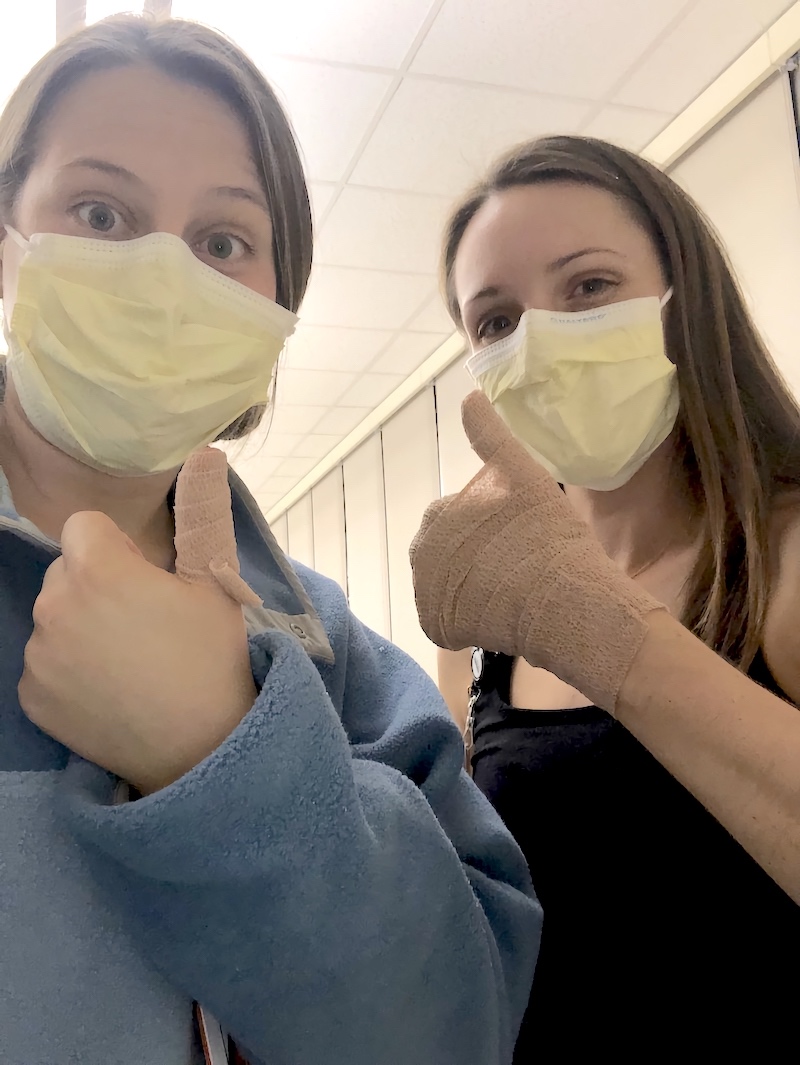
Classmate Alana Schoenhals and I showing off our compression bandage treatment after doing retrograde massage on one another for edema management.
⋯

Tips to Stay Organized ⟩
September 10, 2020, by Savi
During my time in graduate school, I found that success is closely tied to organizational skills. Towards the beginning of each semester, I typically become overwhelmed by my new schedule and all of the combined assignments. I, therefore, have discovered a few simple ways to help ease my concern and make it ALL seem a little more manageable. Here is a list of a few tips you may find helpful to assist you with staying organized throughout the semester.
1. Weekly Schedule
Develop a weekly schedule PDF, Excel, or Word document that you can always refer to when you need to schedule a meeting, a study session with friends, a doctor’s appointment, or time to engage in a meaningful and rejuvenating occupation such as exercising. This weekly schedule can be color-coded and can include everything that you have committed your time to on a continuous weekly basis. This will allow you to view your weekly class, volunteer, fieldwork, and work schedule in one location, making it easy to see what time you have available in order to schedule events or utilize and assign your free time to activities and assignments. I also add in blocks for driving and eating to better understand what time I have completely free and what time I am filling with other necessary occupations. Here is my weekly calendar example:
2. Excel Assignment List
At the start of each semester I go through every single syllabus and note the assignment with the due date on an excel document. I color-code each class and then use the sort tool to organize the assignments by the due date. This way I can scroll through at the end of each week to see what I need to do over the weekend, plan what I can complete during my free time allotted in my weekly schedule, and check to make sure I have completed the all of the assignments before I go to bed each night. This is a quick and easy way to have all the assignments and exam due dates listed in one location! You can also delete the row or change the color of the assignment once it is completed to feel a sense of relief and instant satisfaction. Here is how I created mine:
Savi’s Assignments in an Excel List. To get from the first color-coded list to the second list organized by date due follow these instructions: 1. Highlight the “B” column as demonstrated in the picture on the left. 2. Select “Data” from the drop-down menu at the top of the screen. 3. Select “Sort” and choose the “expand the selection option”. 4. Select “Column B” option from the column drop-down and select the “January, February, March, April . . . December” option from the order dropdown. This option may be listed under “custom list” if you haven’t recently selected it. 5. Select the “ok” button at the bottom of the pop-up box and the excel sheet will sort your data!
3. Digital USC Folder
I created a folder for all things USC on my desktop. Inside this folder, I have created subfolders to save and organize my documents into. For example, I have folders for each semester. Once you open my semester folder you will find a folder listed for each class I am taking. This makes it extremely easy to find my notes, study guides, online textbooks, or anything else I need for each particular class.
4. Sticky Notes
I utilize the sticky note tool on my desktop to write down small to-do lists each day, reminders, and zoom links for class that aren’t linked through blackboard to make them easily accessible. If you do not have the sticky note tool on your desktop you can do this by hand in a planner, on your phone in a notes section, or in a word document that you can continuously update.
5. Shared Calendar
I have developed a monthly calendar that is linked to my computer and to my phone. That way if I add anything on one device it will automatically link to the other. This is helpful if I am out of the house and have to organize a meeting, event, or group project. You can do this on Outlook, Google Calendar, iCal, etc. I add my classes, any breaks or holidays to that calendar, and any appointments or future reminders in this calendar.
I hope this list has provided you with at least one technique that can help you stay organized this semester. Be sure to tailor these items to fit your particular needs!
⋯

Crafting a Personal Statement ⟩
August 26, 2020, by Savi
During my application process, I wanted to make sure that I would stand out. I spent weeks worrying about what I could do to make the admissions team stop and say “WOW” when reading through the hundreds of applications they received that year. This was stressful, to say the least. I felt as though everyone else applying also had good grades and GRE scores. I volunteered in a variety of clinics, held leadership positions in multiple organizations, and participated in an OT research lab throughout my undergraduate career but I knew that most applicants were also very involved. Despite all these achievements I continued to worry about how I could stand out! What would grab the admission counselor’s attention? I soon realized it would have to be my Personal Statement.
The USC Chan Personal Statement was my time to shine. I spent weeks drafting different ideas about what I thought the admissions team wanted to hear. I spoke about my leadership, my academic success, etc. Each time I would read over the new version I didn’t think it was good enough. After speaking to my sister about my dilemma and having her read over my outline she turned to me and said, “Savi we all know you are successful. Now tell them who you are beneath all the success. Who is Savi and why are you built to be an OT?” This quickly made me realize that I had been spending my time writing a personal statement with the sole purpose of impressing the admissions team. Instead, I needed to focus my energy on finding one story that exemplifies who I am and how I fit into the Chan community.
I deleted my list of achievements and started fresh. I brainstormed ideas of when I had implemented techniques similar to OT intervention in a non-traditional setting. I did this because I wanted to demonstrate that my imagination would benefit me as both an OT student at USC and as a future OT practitioner. I landed on my experience as a Human Resources intern at a start-up tech company after my freshman year of college. During my time at this company, I noticed that employees led a primarily sedentary and ergonomically insufficient work lifestyle. I, therefore, focused my time as an intern on developing an innovative approach to educate and enable the employees on adopting a healthy and ergonomically sustainable lifestyle in the office. I used the company’s core values, personalities, and goals to develop the perfect “interventions” based on their needs, including a wellness competition, games to engage in physical activity, and workshops on how to set up their workspace to promote sustained engagement and success.
Looking back on this internship I realized how aligned my innovation skills were with OT techniques. Naturally, I found myself understanding the importance of exploring clients’ situational context, personality, and environment in order to develop innovative treatment plans that promote engagement in meaningful occupations. This story exemplified that even before I decided to pursue a career in OT I utilized the leadership and career opportunities I had to use my creativity to help others . . . sounds kind of like an OT right!? Was this internship the biggest success I have ever achieved? No. Does everyone else applying also have work or internship experience? Yes. Although the experience of being an intern may seem common and unoriginal, I was able to dive deeper into how I utilized one of USC Chan’s core values to demonstrate who I am and what kind of OT I want to be. So dive deeper into those “regular or unoriginal” experiences in order to demonstrate how you made it extraordinary just by being yourself!
You can find more application advice from our Director of Admissions, Dr. Arameh Anvarizadeh in this video!
⋯

What Student Organization Should I Join? ⟩
August 4, 2020, by Savi
As the summer semester is coming to an end and the fall semester is quickly approaching, many students become aware of the various opportunities they have to get involved. Emails start to trickle in informing them of volunteer opportunities, student organizations, student council, student worker positions, and much more. Looking back on my first year, I recall this being one of the most overwhelming times for me because I didn’t know which organization would be the best fit for me. For that reason, I have gone ahead and reached out to individuals in our program who are involved in each organization. I asked them why they chose to be a part of this organization and what they have gained from or learned about by being a member. Hopefully, this helps you decide what you want to be a part of!
I do want to echo Calvin, Lamoni, and Marilyn’s blog posts by reminding you all that it is ok to say no and that it is important to maintain a proper work-life balance. You do not have to be a part of multiple or any organizations for that matter! I urge you to invest time in things that matter to you. For the first three semesters of graduate school, I only committed my time to schoolwork and my job as a gym receptionist. It wasn’t until the Student Ambassador position presented itself at the end of my Spring semester that I found myself getting more involved in the Chan community outside of class. Whether your meaningful occupations fall within or outside our program, find one or two activities or organizations that you are passionate about. Try your best not to overcommit yourself and do not feel like you have to rush into a decision. If you are unsure about an opportunity I can promise you that a new one will be just around the corner! With that being said . . . here are students’ insight on their student organizations.
- OTs for OuTreach: “I chose to get involved with OTs for OuTreach because I wanted to be able to connect with other people in the program that aligned with my queer identity and be able to talk about our shared experiences throughout the program together. I was really searching for a sense of community and also a way I could get involved with the LGBTQ+ community in Los Angeles through community services/volunteer opportunities. I have always been involved in some way with queer organizations in high school and in undergrad so having a queer org in graduate school was essential for me to find community at the start of a new chapter in my life.” — Gabe Cravens; President of OTs for OuTreach
- Coalition of Occupational Therapy Advocates for Diversity (COTAD): “My COTAD team knows about the importance of representation. Many people do not apply to programs like ours because they don’t see anyone like them. And a lot of people don’t know about occupational therapy because it’s mainly a white, female, heterosexual, middle-class profession. So, establishing a COTAD chapter at USC felt really important (I think every OT program should have a chapter). Along with those points, the OS seminar has really emphasized cultural values and how that shapes people’s occupations. COTAD can bring more insight into those views by advocating for diversity. Taking on the role of chapter president made me nervous because of the time commitment but so many people have reached out saying that they want to get more involved, they’ve pitched in ideas on what our chapter should do, helped plan events. It truly ends up being a team effort. Because of that, Its a lot less overwhelming than I thought it would be. And we’ve only been established for a few months. We’re coming off the ground (which is the hardest part) so I can’t wait until the future when everything is rolling.” — Lamoni Lucas; COTAD Chair
- USC Occupational Therapy and Science Council (OTSC): “Being a part of OTSC has taught me how important it is to listen to the student body’s values and what they truly want from a governing student council, being the social media chair has taught me how important connection is, especially during this global pandemic in which we are all undergoing remote learning and our connections are no longer in person. We have been able to create a strong virtual bond regardless of external factors we have no control over, and that is why I decided to join OTSC, to connect and create the best graduate experience possible for all students!” — Samantha Coelho; OTSC Social Media Representative
- Pi Theta Epsilon (PTE): “I was interested in PTE because it was different from other organizations. PTE has a major focus on scholarship and research opportunities. As a research assistant, I have learned more about all of the cool things OS and OT research labs are working on, so I wanted to get involved in an organization that focused on conversations surrounding these topics. As a PTE member, I can utilize the division’s expansive resources to learn from a variety of Chan faulty and staff. Although we aren’t following the regular events we usually put on due to COVID-19 restrictions, we are taking more time to implement interdisciplinary programming with students in other health disciplines. We have developed an OT and PT forum to talk about case studies and build treatment plans together, and we are also adapting events to work with other PTE chapters. This organization takes its own spin on promoting scholarship and fostering opportunities to work in transdisciplinary teams.” — Renee Reinberg; Co-President of PTE
- USC Student-Run Clinic (SRC): “Before coming into OT school, I worked in an interdisciplinary clinic for children who’ve experienced trauma. I shadowed an OT and observed how she worked alongside a team of health professionals to tackle very complex situations. When I came into USC, I was very excited to be a part of the SRC, where different disciplines could also come together to work on healthcare cases for vulnerable populations. Being in SRC challenged my assumptions of other health professions and brought me more understanding of the unique role that each healthcare member contributes to the team. This experience also helped me feel more comfortable advocating for the importance of OT, both with clients and with other health professionals, as a means to serve complex populations more effectively as a team.” — Katherine Tao; JWCH Clinic Site Coordinator
- The Chan Community Commission (CCC): “Joining CCC was kind of serendipitous because my friend Sarah Morris and I wanted to create a peer mentorship program for incoming students during summer. We reached out to Dr. Rafeedie with the idea and were added to the taskforce that ended up evolving into the CCC! I have definitely enjoyed working together with such wonderful passionate people to make CCC a reality and share ideas and bring them to fruition.” — Kayla Jahari; Co-Leader of the Peer Mentorship Circles in CCC
- The Chan Community Commission (CCC) Continued:“For me, being a member of the Chan Community Commission (CCC) this summer has been a wellspring of hope and positive energy in the midst of the most tumultuous socio-political period of my life. I am grateful for the opportunity to collaborate with the CCC team to create opportunities for Chan students and faculty to build community and practice wellness together. I am looking forward to continuing to strengthen our OT community this fall as part of the OTSC Philanthropy Committee!”
— Adam Strizich; CCC Health & Wellness Sub-Committee Lead
**As Adam has mentioned the CCC will no longer continue under this title in the Fall, so please click here to learn more about the future of CCC and how they are uniting with OTSC and Global Initiatives.
⋯

When a Planner’s Plan Doesn’t go to Plan ⟩
July 21, 2020, by Savi
You never know where you are going to end up. This was a comment I heard from a lot of USC faculty and staff during my first summer in the Master’s program. I would chuckle and dismiss these comments because I have always known what setting I wanted to work in as an occupational therapist (OT). When I have a plan I rarely sway from it. After deciding to pursue a career as an OT in acute care during my junior year of high school, I did everything I could to fulfill this dream of mine.
Upon entering into my first immersion, mental health, I had already convinced myself that this was not the field I was going to work in. As I attended more classes, participated in group discussions, and immersed myself in an eye-opening fieldwork placement, I soon came to realize that my plan to pursue a career in acute care may not be my goal after all. In this fieldwork setting I listened to my clients’ stories and worked with them to overcome the mental health barriers they faced to become better mothers. This experience made me realize that my love for working with clients to improve both mental and physical health in order to engage in meaningful occupations can be applied in a variety of settings. For the first time in a while, I was confused about where I was going to end up, and that made me feel uneasy.
It was not until I was introduced to my faculty mentor, Kimberly Perring Lenington, that I came to terms with the fact that my confusion was a good thing and not something to be afraid of. I instantly admired Dr. Lenington for achieving my original goal of working in the acute care setting directly after graduating from USC. I remember asking Dr. Lenington if this was her goal all along and recall her explaining that this was not her plan. She fell into this setting and loves it. I was shocked. I didn’t have to plan my entire career from high school in order to be successful in my field of choice?
While learning more about Dr. Lenington I discovered a niche specialty I was never aware of. Dr. Lenington also treats individuals with various pelvic health diagnoses including incontinence, pelvic pain, and sexual dysfunction. After diving deeper into this pelvic health specialty and learning more about OT’s role in sexual health in my OT 534 Health Promotion and Wellness course, I became fascinated by the opportunity to work with women to help them holistically. In this setting, I could tackle the mental and physical barriers to achieving pelvic health in order to help women participate in meaningful occupations. Let’s just say I was immediately hooked!
Although I am still passionate about the possibility of working in an acute care setting, I have come to the understanding that I must allow myself to keep an open mind. Without doing so I would have never discovered the pelvic health specialty that I am now extremely excited about. It is ok to be confused about where you want to be once you graduate. This confusion is truly a gift. Allowing yourself to keep an open mind, in turn, widens the realm of possibilities. So to those who are planners like me, know that it is all right to redo your plan. Keep your options open . . . you never know what opportunities could be coming your way!
⋯






